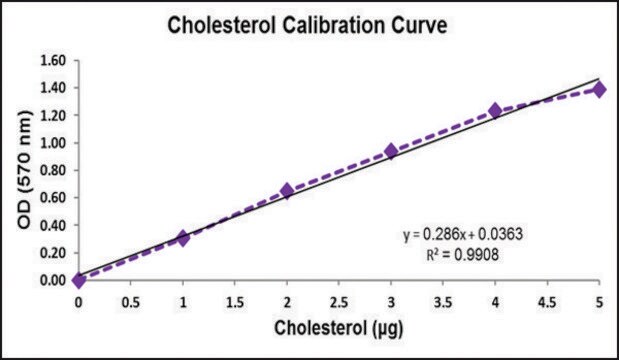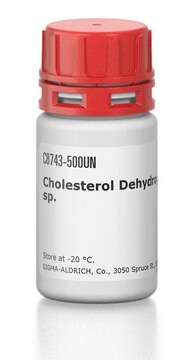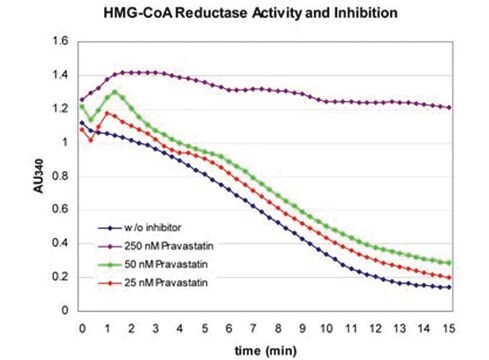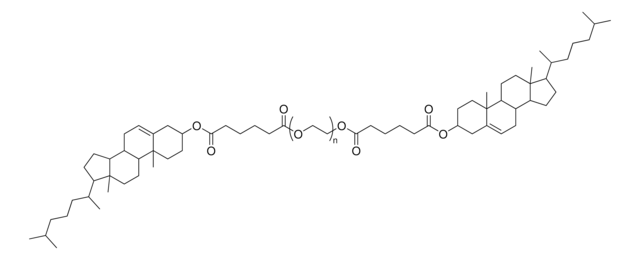추천 제품
사용
sufficient for 100 tests
Quality Level
포장
pkg of 1 96-well plate(s)
제조업체/상표
Calbiochem®
저장 조건
OK to freeze
protect from light
assay range
standard curve range: 0.2-10 μg/well
입력
sample type serum
sample type cells
sample type tissue(s)
배송 상태
wet ice
저장 온도
−20°C
일반 설명
A sensitive assay for the quantitative measurement of cholesterol and/or cholesteryl ester by a colorimetric or a fluorometric method. Measurement by spectrophotometry at OD =570 nm or fluorometry at Ex/Em =535/587 nm. This assay can measure cholesterol itself, total cholesterol (cholesterol + cholesterol ester) by adding cholesterol esterase to the reaction, or only cholesteryl ester by subtracting the value of cholesterol from the total value of cholesterol plus cholesteryl esters. The fluorometric assay can detect 0.02-1 µg/well and is 4-10 fold more sensitive than colorimetric assay. Kit contains sufficient reagents for 100 tests.
성분
Cholesterol Reaction Buffer, Cholesterol Probe, Dimethylsulfoxide, Enzyme Mix, Cholesterol Esterase, Cholesterol Standard, and a user protocol.
경고
Toxicity: Multiple Toxicity Values, refer to MSDS (O)
제조 메모
1. Serum: The recommended volume of serum is 0.5-5 µl. Serum samples should be diluted 10-fold in Cholesterol Assay Buffer.
2. Cell Lysates and Tissue Extracts: Homogenize 1 x 106 cells or 10 mg tissue in 200 µl Chloroform:Isopropanol:NP-40 (7:11:0.1) in a microhomogenizer. Centrifuge for 5-10 min at 14,000 rpm in a microcentrifuge. Avoiding the whitish solid protein layer, collect the organic phase (lower phase) and transfer it to a clean tube; air-dry at 50°C, and vacuum-dry for 30 min to remove residual chloroform. Dissolve the dried lipids in 200 µl Cholesterol Reaction Buffer by vortexing extensively for 5 min. Use 1-50 µl extracted sample per assay. The extraction procedure can be scaled up if larger amounts of sample are desired. Use 1-50 µl of extracted sample per assay. Then adjust the volume to 50 µl/well with Cholesterol Assay Buffer. For unkown samples, we suggest testing differant amounts of sample to ensure that the readings are within the linear portion of the standard curve.
2. Cell Lysates and Tissue Extracts: Homogenize 1 x 106 cells or 10 mg tissue in 200 µl Chloroform:Isopropanol:NP-40 (7:11:0.1) in a microhomogenizer. Centrifuge for 5-10 min at 14,000 rpm in a microcentrifuge. Avoiding the whitish solid protein layer, collect the organic phase (lower phase) and transfer it to a clean tube; air-dry at 50°C, and vacuum-dry for 30 min to remove residual chloroform. Dissolve the dried lipids in 200 µl Cholesterol Reaction Buffer by vortexing extensively for 5 min. Use 1-50 µl extracted sample per assay. The extraction procedure can be scaled up if larger amounts of sample are desired. Use 1-50 µl of extracted sample per assay. Then adjust the volume to 50 µl/well with Cholesterol Assay Buffer. For unkown samples, we suggest testing differant amounts of sample to ensure that the readings are within the linear portion of the standard curve.
Note: Allow reagents to warm to room temperature. Briefly centrifuge all vials before opening.
• Cholesterol Probe: Ready to use as supplied. Warm to room temperature to thaw the DMSO solution before use. Aliquot and freeze at -20°C; protect from light. Cholesterol Probe is stable for up to 2 months at -20°C.
• Cholesterol Esterase: Dissolve the Cholesterol Esterase in 220 l Cholesterol Reaction Buffer prior to use. Aliquot and freeze at -20°C. Reconstituted Cholesterol Esterase is stable for up to 2 months at -20°C.
• Enzyme Mix: Dissolve the Enzyme Mix in 220 l Cholesterol Reaction Buffer prior to use. Aliquot and freeze at -20°C. Reconstituted Enzyme Mix is stable for up to 2 months at -20°C.
• Standard Curve, Colorimetric Detection: Dilute the Cholesterol Standard to a concentration of 0.5 g/l by adding 20 l Cholesterol Standard to 180 l Cholesterol Reaction Buffer; mix well. Add the indicated volumes of diluted Cholesterol Standard and Cholesterol Reaction Buffer (see table below) to individual designated standard wells.
<div class="Bio_doc_image"><p class="title">Table 1: Sample Dilutions
</div>
• Standard Curve, Fluorometric Detection: Dilute the Cholesterol Standard to 50 ng/l by adding 10 l Cholesterol Standard to 990 l Cholesterol Reaction Buffer; mix well. Add the indicated volumes of diluted Cholesterol Standard and Cholesterol Reaction Buffer (see table below) to individual designated standard wells.
<div class="Bio_doc_image">Table 2: Sample Dilutions
</div>
Note: For the standard curve (colorimetric and fluorescent detection), cholesterol esterase MUST be added to the reaction mix for detecting either total cholesterol or free cholesterol.
• Reaction Mix: Prepare the following Reaction Mix; prepare only enough reaction mix for the number of assays to be performed. The total volume of reaction mix in each well is 50 l.
44 l Cholesterol Reaction Buffer
2 l Cholesterol Probe
2 l Enzyme Mix
2 l Cholesterol Esterase*
*Note: Cholesterol Esterase hydrolyzes cholesteryl ester into cholesterol. If you want to detect cholesterol only, omit the Cholesterol Esterase. With the addition of Cholesterol Esterase, the assay detects both cholesterol and cholesteryl esters. If you want to detect cholesteryl esters only, subtract the value of cholesterol from the total value of both cholesterol and cholesteryl esters.
• Cholesterol Probe: Ready to use as supplied. Warm to room temperature to thaw the DMSO solution before use. Aliquot and freeze at -20°C; protect from light. Cholesterol Probe is stable for up to 2 months at -20°C.
• Cholesterol Esterase: Dissolve the Cholesterol Esterase in 220 l Cholesterol Reaction Buffer prior to use. Aliquot and freeze at -20°C. Reconstituted Cholesterol Esterase is stable for up to 2 months at -20°C.
• Enzyme Mix: Dissolve the Enzyme Mix in 220 l Cholesterol Reaction Buffer prior to use. Aliquot and freeze at -20°C. Reconstituted Enzyme Mix is stable for up to 2 months at -20°C.
• Standard Curve, Colorimetric Detection: Dilute the Cholesterol Standard to a concentration of 0.5 g/l by adding 20 l Cholesterol Standard to 180 l Cholesterol Reaction Buffer; mix well. Add the indicated volumes of diluted Cholesterol Standard and Cholesterol Reaction Buffer (see table below) to individual designated standard wells.
<div class="Bio_doc_image"><p class="title">Table 1: Sample Dilutions
</div>
• Standard Curve, Fluorometric Detection: Dilute the Cholesterol Standard to 50 ng/l by adding 10 l Cholesterol Standard to 990 l Cholesterol Reaction Buffer; mix well. Add the indicated volumes of diluted Cholesterol Standard and Cholesterol Reaction Buffer (see table below) to individual designated standard wells.
<div class="Bio_doc_image">Table 2: Sample Dilutions
</div>
Note: For the standard curve (colorimetric and fluorescent detection), cholesterol esterase MUST be added to the reaction mix for detecting either total cholesterol or free cholesterol.
• Reaction Mix: Prepare the following Reaction Mix; prepare only enough reaction mix for the number of assays to be performed. The total volume of reaction mix in each well is 50 l.
44 l Cholesterol Reaction Buffer
2 l Cholesterol Probe
2 l Enzyme Mix
2 l Cholesterol Esterase*
*Note: Cholesterol Esterase hydrolyzes cholesteryl ester into cholesterol. If you want to detect cholesterol only, omit the Cholesterol Esterase. With the addition of Cholesterol Esterase, the assay detects both cholesterol and cholesteryl esters. If you want to detect cholesteryl esters only, subtract the value of cholesterol from the total value of both cholesterol and cholesteryl esters.
법적 정보
CALBIOCHEM is a registered trademark of Merck KGaA, Darmstadt, Germany
신호어
Danger
유해 및 위험 성명서
Hazard Classifications
Resp. Sens. 1 - Skin Sens. 1
Storage Class Code
10 - Combustible liquids
시험 성적서(COA)
제품의 로트/배치 번호를 입력하여 시험 성적서(COA)을 검색하십시오. 로트 및 배치 번호는 제품 라벨에 있는 ‘로트’ 또는 ‘배치’라는 용어 뒤에서 찾을 수 있습니다.
이미 열람한 고객
Ghazala Iqbal et al.
Frontiers in aging neuroscience, 12, 223-223 (2020-08-28)
Numerous studies have identified an association between age-related cognitive impairment (CI) and oxidative damage, accumulation of metals, amyloid levels, tau, and deranged lipid profile. There is a concerted effort to establish the reliability of these blood-based biomarkers for predictive diagnosis
Ilke Vermeulen et al.
Journal of lipid research, 58(4), 709-718 (2017-02-15)
The differentiation of macrophages into lipid-filled foam cells is a hallmark of the lung granuloma that forms in patients with active tuberculosis (TB). Mycolic acids (MAs), the abundant lipid virulence factors in the cell wall of Mycobacterium tuberculosis (Mtb), can
Aurélie Vega et al.
PloS one, 10(10), e0139946-e0139946 (2015-10-07)
Bile acids have recently been demonstrated as molecules with endocrine activities controlling several physiological functions such as immunity and glucose homeostases. They act mainly through two receptors, the nuclear receptor Farnesol-X-Receptor alpha (FXRα) and the G-protein coupled receptor (TGR5). These
Wan Yun Ho et al.
The Journal of cell biology, 220(9) (2021-08-05)
Cholesterol metabolism operates autonomously within the central nervous system (CNS), where the majority of cholesterol resides in myelin. We demonstrate that TDP-43, the pathological signature protein for amyotrophic lateral sclerosis (ALS) and frontotemporal dementia (FTD), influences cholesterol metabolism in oligodendrocytes.
Estela Area-Gomez et al.
The EMBO journal, 31(21), 4106-4123 (2012-08-16)
Alzheimer disease (AD) is associated with aberrant processing of the amyloid precursor protein (APP) by γ-secretase, via an unknown mechanism. We recently showed that presenilin-1 and -2, the catalytic components of γ-secretase, and γ-secretase activity itself, are highly enriched in
자사의 과학자팀은 생명 과학, 재료 과학, 화학 합성, 크로마토그래피, 분석 및 기타 많은 영역을 포함한 모든 과학 분야에 경험이 있습니다..
고객지원팀으로 연락바랍니다.











